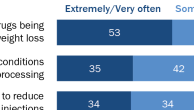I recently helped my parents enroll in their new Medicare prescription drug plans using the Medicare.gov website. It was a good-news, bad-news experience. Overall, the good news is that the Medicare.gov website provides very thorough information, is mostly easy to use, and includes efficient functionality. The bad news is that successfully enrolling online requires the guiding hand of a practiced internet user, includes several unanticipated offline data-gathering moments, and probably also includes a few false starts. Here is my mom’s story.
Bad news: Before starting, a list of necessary information would have saved several phone calls and re-starts: name, address, social security number, date of eligibility for Medicare’s Hospital Part A and Medical Part B, list of regular drugs and dosages, and individual drug costs, current prescription coverage, preferred pharmacy (if important), and decision on option to deduct plan costs from monthly Social Security check.
Good news: First step, to search for and compare plans. I plugged in my mom’s south Florida zip code, which later revealed there are 44 plans available in her area, and her current coverage, “none of the above” — a blessing in disguise as we avoided comparing possible plans to the specifics of any current plan. We were also lucky that, because of her relatively simple drug requirements, she fell into the category easiest to maneuver. There was no need to worry about gaps in coverage beyond certain expenditures.
Bad news: I did not know how to answer the polite, but fuzzy Medicare question asking “Did you get a letter from either Medicare or the Social Security Agency that said you are either eligible for or qualified for “extra help” paying for your Medicare prescription drug care costs.” Huh? My mom wasn’t sure, and one very long telephone call to the toll free Medicare number eventually interpreted “extra help” as jargon for Medicaid eligibility. Why not just say that?
Good news/bad news: We clicked to “choose a plan” and then “Enter medications”, two steps which seem entirely reasonable in retrospect, but were presented in succession as one of several options where we could easily have tripped up and had to backtrack to get our desired information.
Good news: Plugging in the drugs. The process includes excellent, transparent functionality to plug in drugs (including a search-by-alphabet aid for cases where the exact name doesn’t quite match the one on the bottle), the dosage (including a drop-down menu to adjust the dosage, although one dosage that my mom takes wasn’t an exact match), and a query asking if you’ll accept the generic version. (Note to self: Glitch – phone physician to see if generic is acceptable and if it affects ultimate costs.)
Excellent news: Comparing coverage plans. (Fair warning: don’t be sidetracked. We chose to bypass the chance to select a specific pharmacy and see what Medicare had to offer. Right choice! The pharmacies are not all current on the website, and you can cross-check for your favorite one later. The point here is to get a cost comparison of the plans.) Eureka! We were quickly offered 44 plans, listed according to estimated annual costs. Clicking within individual plans reveals a goldmine of details of annual costs, including deductibles, monthly co-pays per drug (as price points of different drugs vary wildly among plans, revealing why individually-tailored plan selection is critical), mail-order options, special notes, and many more things. You can also click to compare specifics of up to 3 plans at a time.
Bad news: Finding cooperating pharmacies can be frustrating and requires a leap of faith. The website’s pharmacy list wasn’t current, and I was derailed from the internet to the telephone. I called my mom’s favorite pharmacy, talked to her favorite pharmacist, and learned that they expected to cooperate with the plan we liked. Ya gotta love small town south Florida; I know I would not have such quick or trustworthy service where I live.
Good news: Enroll. Just plug in the usual information, which included a rather puzzling and unexplained bonus question of whether or not you lived in a nursing home.
Total time elapsed: Internet time about 30 minutes. Other time included calls to parents for information and decisions: 30 minutes; call to Medicare: 45 minutes; call to pharmacist: 3 tries and 10 minutes; call to physician re generic drug possibility: did not try.
Total cost savings: My mom was self-paying for drugs at a cost of about $3000 per year. Under her new Medicare D plan, it will cost her less than one third of that.
Epilog: My mom received her new Medicare D prescription drug enrollment card in the mail. Her pharmacist said the pharmacy does cooperate with her plan. She has not yet tried to get any prescriptions filled.
Reality check from findings from the Pew Internet Project:
• As of September, 2005, 30% of people age 65 years and over use the internet.
• As of 2002, 39% of internet users have helped another person with online medical issues
• As of November, 2004, 54% of internet users have gone to a government website to look for information.
• In August, 2003, more internet users had visited government websites for information (66%), statistics or documents (41%), and recreation or tourist information (34%), than health or safety issues (28%).




